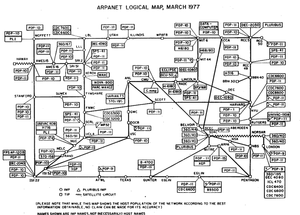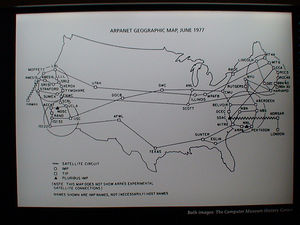ARPANET
In January 1969, the Advanced Research Projects Agency of the Department of Defense (ARPA) awarded a contract to Bolt, Beranek and Newman (BBN) to design and construct a communications network. By the end of 1969, an experimental ARPANET was operational between four university nodes. This system was the forerunner of the Internet.
Packet switching was developed independently by RAND researcher Paul Baran and British scientist Donald Davies. It is a communication method that took all kinds of data, queued it up, and packaged it into blocks that were sent together as a stream.
Lawrence Roberts, the ARPANET program manager, recognized that packet switching, which used a variable stream of data, would more effectively transmit data among a network of computers than circuit switching, which demanded a constant rate and led to delay.
Meanwhile, BBN, formed by MIT faculty members Richard H. Bolt, Leo Beranek, and Robert B. Newman, expanded from its initial specialty into acoustics into computers in the late 1950s. BBN bought Digital Corporation’s first PDP-1 and used it to develop computer solutions to hospital care. Working for the National Institutes of Health and Massachusetts General Hospital, BNN used the PDP-1 to build the first time sharing system, which allowed four simultaneous users to work on one computer.
In July, 1968, ARPA sent to a proposal for bids on a device called the Interface Message Processor (IMP). The technology would allow a network of “Host Computers” to communicate with one another. BBN had gathered a team of well-regarded computer researchers, including Frank Heart, Dave Walden, Bernie Cosell, Severo Ornstein, Robert Kahn and Will Crowther. Beating out much larger competitors, BBN won the contract and successfully developed the IMP by September, 1969.
ARPANET became active between four university nodes by the end of the year: Leonard Kleinrock's lab at the University of California-Los Angeles, the Stanford Research Institute (SRI), the University of California-Santa Barbara, and the University of Utah. ARPANET’s use of packet switching made it attractive as a basis for a growing international network of computer users by the early 1970s, who found that this method could connect computers with different types of terminal equipment.
Further Reading
Inception of the ARPANET, 1969 - IEEE Milestone

